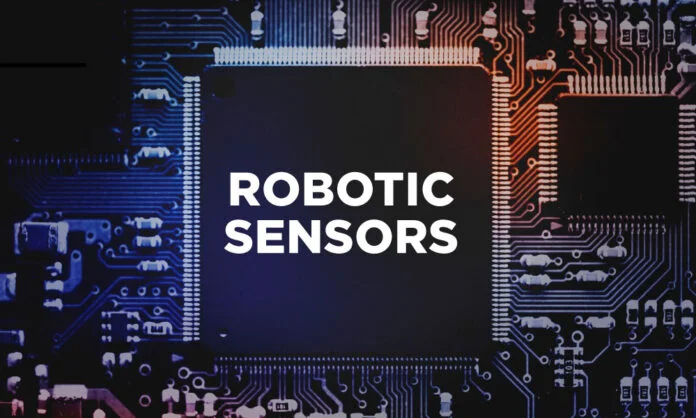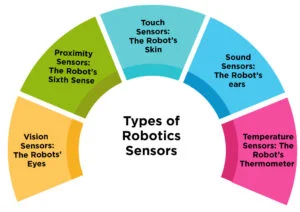Robotics technology is growing unprecedentedly. From manufacturing to healthcare, almost every industry is using robotics in their businesses. Robotics technology has become more important than any other. It is because of the ability of robots to interact with the environment effectively. And this effective performance with the surroundings is possible because of the sensors built into them.
Robotic sensors have become more common; it is expected that the global robotics market will grow at a CAGR of 16% by 2030. In this blog, we will understand different types of robotics sensors and how they interact with the environment.
What Are Sensors?
Sensors are devices that are able to sense the changes in the environment. They translate these changes into signals that machines can understand. The sensors can sense the light, sound, temperature, or movement and send that information to the robots. This helps the robot to understand what is happening around them.
Robotic sensors are like the “senses” of a robot. Just as humans use their eyes to look, ears to listen, and skin to touch, robots use sensors to perceive the world around them.
Role of Sensors in Robotics:
In robotics, sensors connect the robot to its surroundings. They help the robot to ‘see’ objects around them. Sensors allow robots to ‘hear’ different sounds or instructions. Robots are able to ‘feel’ the touch and even ‘smell’ different gases surrounding them with the help of sensors. Without sensors, robots are like blind humans who are unable to perform simple and easy tasks.
Types of Robotics Sensors:
Robots use different types of sensors to collect information around them. Each sensor is used for different purposes. Some of the common types of robotic sensors used by robots are:
INT IMAGE
1. Vision Sensors: The Robots’ Eyes
These robotic sensors allow robots to see. It helps robots to recognize objects. The sensor helps them to detect colors, shapes, and movement.
For example, a factory robot installed with a vision sensor is capable of finding faulty products that move on a conveyor belt.
2. Proximity Sensors: The Robot’s Sixth Sense
Proximity sensors help the robot to sense the object near to them. They are important to avoid obstacles. These sensors are used mostly in self-driving cars to prevent crashes.
3. Touch Sensors: The Robot’s Skin
In robotics, touch sensors act like human skin. These sensors allow robots to feel the surrounding pressure, texture, and temperature around them. It is helpful in industries where robots have to handle fragile items.
4. Sound Sensors: The Robot’s ears
Sound sensors, or microphones, help robots to hear and understand surrounding sounds. These sensors are used in voice-controlled robots, like smart assistants. Such robotic sensors follow human commands. Example, Alexa and Siri.
5. Temperature Sensors: The Robot’s Thermometer
Temperature sensors measure heat and cold. They are used in robots that work in extreme conditions, like firefighting robots or those in cold storage areas.
How Do Sensors Make Robots Smarter?
Sensors make robots intelligent and adaptable. Let us see how they work together to give robots superpowers:
- Sensing the Environment: Sensors collect data from the surrounding environment. This data is then sent to the robot’s brain for further processing.
- Making Decisions: Once the robot receives the data, it analyzes it and decides what steps it needs to take next.
- For example, if a proximity sensor finds an obstacle, the robot is able to decide to stop or change the action.
- Taking Action: After taking the decision the robot decides to take action on a particular task. This action can be picking of an object or moving that object to a different location.
Applications of Robotic Sensors in Real Life:
Robotic sensors are applied in nearly every area where robots are used. Below are some interesting examples:
Healthcare Robots
Robots with vision and touch sensors in hospitals help surgeons during operations. It allows doctors to carry out precise and delicate procedures.
As per reports say that from 2020 to 2030, robotic surgeries in the U.S. will grow by 10.5% each year. By 2030, the medical robot industry, including care robots, will generate revenue of around USD 14.5 billion.
Self-Driving Cars
Self-driving vehicles use cameras, radar, and LiDAR sensors to drive on roads. These sensors detect obstacles and provide passenger safety.
Industrial Robots
In factories, robots with proximity and vision sensors assemble products, inspect quality, and even pack items for shipping.
Home Robots
Ever seen a robot vacuum cleaner? These handy devices use sensors to map your home, avoid furniture, and clean efficiently.
The Future of Sensors in Robotics!
The robotic sensors world is distinctly changing every day. Scientists are trying to invent even better sensors that will better imitate the human senses. For instance, scientists are inventing sensors that can smell or even sense emotions!
As sensors evolve, robots are going to become smarter, efficient, and powerful enough to conduct complex tasks. Who knows? Perhaps in the future, robots will be able to cook, clean, and even keep us company—all this is made possible because of sensors.
Wrapping Up!
Sensors are the heroes of robotics. They help robots to notice, understand, and engage with the world. They are required in so many industries. A robot vacuuming your living room to self-driving cars, the robotic sensors make it all happen.
So, the next time you spot a robot in action, remember it is the sensor in robotics that is working overtime behind the scenes.
Want to know more about what is new in robotics? Visit YourTechDiet!
FAQ
1. What is a sensor in robotics?
Answer: A sensor in robotics is an element that helps robots to sense the objects around them. It collects information about the world for robots.
2. What is an AI sensor?
Answer: An AI sensor is a smart device that notices things and learns from them. It helps robots make smarter choices based on what they detect.
3. Mention the four types of sensors.
Answer: The four types of sensors are:
- Analog sensors
- Digital sensors
- Passive sensors
- Active sensors
Also Read: How robotics has transformed the healthcare industry?


